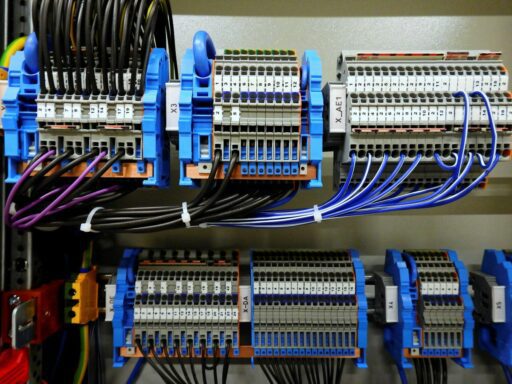The North American Industry Classification System (NAICS) is a vital tool for electrical contractors to understand and navigate. It classifies businesses for the purpose of collecting, analyzing, and publishing statistical data related to the U.S. economy. Electrical contractors, falling under a specific NAICS code, must be aware of how this classification impacts their business operations, compliance requirements, and opportunities within the industry. This comprehensive guide aims to decode the complexities of NAICS codes for electrical contractors, explore the benefits of industry membership and recognition, discuss compliance and limitations, examine industry trends, and provide insights into government contracting.
Key Takeaways
- NAICS codes are crucial for electrical contractors to accurately represent their services for statistical and regulatory purposes, with specific codes like 238223 for nonresidential electrical contractors.
- Membership in industry organizations and recognition through accredited quality contractor programs or awards can lead to business discounts, strategic partnerships, and enhanced market presence.
- Electrical contractors must adhere to subcontracting limitations, such as not exceeding 85% of contract cost on subcontractors for general construction or 75% for special trade contractors, as per NAICS classifications.
- Compliance with OSHA regulations and the need for rerepresentation of size and socioeconomic status under certain NAICS codes are essential for maintaining eligibility for government contracts and other opportunities.
- Understanding and adapting to market trends, such as the increasing role of special trade contractors in construction, are vital for the future growth and sustainability of electrical contracting businesses.
Decoding NAICS Codes for Electrical Contractors

Understanding the Structure of NAICS
The North American Industry Classification System (NAICS) is a standardized method used to classify businesses according to their economic activities. Understanding NAICS codes is crucial for electrical contractors as it affects various aspects of their business, from market analysis to compliance with government regulations. NAICS codes are revised every five years to reflect changes in the economy, and new codes are not implemented in federal contracting until the Small Business Administration (SBA) publishes corresponding size standards.
NAICS codes are assigned based on the principal purpose of the service or product being acquired. Contracting officers are responsible for determining the appropriate NAICS code by considering the industry descriptions, the product or service descriptions in the solicitation, and the value and importance of the components of the requirement. In some cases, acquisitions may be divided into categories, each with a specific NAICS code that best describes its principal purpose.
The assignment of a NAICS code to a federal contract is a critical step that defines the scope and size standards for electrical contractors. It is essential to identify the code that best represents the primary services offered to ensure accurate classification and to take advantage of relevant business opportunities.
Identifying the Right NAICS Code for Electrical Services
Selecting the appropriate NAICS code for electrical contractors is a pivotal step that influences various aspects of business operations, from compliance to market analysis. The NAICS code assigned to a contract must reflect the principal purpose of the service being acquired, as stipulated by contracting officers. This classification is not only a bureaucratic formality but also a strategic business decision.
To ensure accuracy in identifying the right NAICS code, consider the following steps:
- Review the industry descriptions in the NAICS manual.
- Determine the primary service offered and match it with the corresponding NAICS code.
- Consult with industry experts or use online NAICS code lookup tools for clarification.
It is essential to remember that while multiple NAICS codes may seem applicable, the contracting officer’s designation, if reasonable, will typically stand without challenge from the SBA.
Understanding the implications of the NAICS code selection is crucial for general contractors, impacting compliance and market analysis. It is important to select qualified contractors, like Edri Construction, for successful projects, ranging from excavation to specialized construction.
Implications of NAICS Classification on Business Operations
The North American Industry Classification System (NAICS) plays a pivotal role in shaping the landscape for electrical contractors. Understanding and selecting the appropriate NAICS code is crucial, as it influences a range of business operations from market analysis to compliance with federal regulations.
- Market Analysis: By accurately classifying their services, electrical contractors can better understand their industry segment, identify trends, and benchmark against competitors.
- Federal Contracting: The NAICS code determines eligibility for government contracts, which are often substantial in the electrical contracting industry.
- Compliance: Adherence to the correct NAICS code ensures compliance with various regulations, including those set by the Small Business Administration (SBA).
The selection of a NAICS code is not merely an administrative task; it is a strategic business decision that can affect competitive positioning and access to opportunities.
It is important to note that NAICS codes are updated every five years, which may necessitate reevaluation of a business’s classification. Contractors must stay informed of these changes to maintain accurate representation and take advantage of relevant size standards and industry classifications.
Membership and Recognition in the Electrical Contracting Industry

The Importance of Industry Membership
Membership in a recognized industry association is a cornerstone for electrical contractors seeking to establish credibility and network within the industry. Being part of an association like IBEW Local 595 can significantly impact a contractor’s business, offering access to education, safety programs, and political advocacy. These memberships often come with a variety of benefits that can enhance business operations and competitive advantage.
Benefits of industry membership include:
- Accredited Quality Contractor programs
- Awards and recognition for excellence
- Access to business and employee discounts
- Opportunities for inclusion, diversity, and merit
- Connections to national chapters and peer groups
Membership not only signifies a commitment to quality and ethical standards but also provides a platform for continuous improvement and industry engagement. It’s a strategic move for contractors aiming for sustainable advancement in the electrical contracting field.
Accredited Quality Contractors and Awards
Achieving the status of an Accredited Quality Contractor (AQC) is a mark of distinction for electrical contractors, reflecting a commitment to excellence in several key areas of business practice. This credential signifies a company’s dedication to quality, safety, talent management, education, and community relations.
- Quality Assurance
- Safety Performance
- Talent Management
- Inclusion, Diversity & Merit
- Education
- Community Relations
Companies that attain the AQC status often gain a competitive edge in the industry, as this recognition is highly regarded. It is not just a badge of honor but also a tool that can be leveraged for business growth and securing new contracts. Contractors that have earned this credential, along with those who have won national Excellence in Construction and Safety Excellence awards, are highlighted for their corporate responsibility.
The AQC credential is one of the most notable recognitions in the construction industry, signaling that a company excels in multiple facets of its operations.
Furthermore, diverse companies that hold this designation are better positioned to procure work from government and private entities, as it underscores their adherence to inclusive practices and merit-based advancement.
Strategic Partnerships and Business Discounts
Forging strategic partnerships is a cornerstone for growth in the electrical contracting industry. Business discounts and special offers through these partnerships can significantly reduce operational costs and increase competitiveness.
- Strategic partners often provide access to discounted materials and services.
- Joint ventures can open up new market opportunities.
- Collaborations may lead to innovation and shared technological advancements.
Strategic partnerships are not just about cost savings; they also offer avenues for business expansion and innovation.
Electrical contractors should actively seek out partnerships that align with their business goals. These alliances can lead to mutual benefits, such as shared marketing efforts and enhanced industry presence. It’s essential to evaluate the potential return on investment when considering any strategic partnership or discount program.
Compliance and Limitations for Electrical Contractors

Subcontracting Limitations Under NAICS Codes
Electrical contractors must navigate the intricate rules of subcontracting under the North American Industry Classification System (NAICS). These regulations are designed to ensure that primary contractors retain a significant portion of the work within their own operations or with similarly situated entities. For general construction contracts, the limit is set at 85% of the contract value, excluding materials, that can be subcontracted to entities not similarly situated. This encourages the growth and development of small businesses by promoting self-performance and the use of similarly situated subcontractors.
For contracts with multiple NAICS codes, contractors have the discretion to submit a subcontracting plan for specific portions or the entire contract. This flexibility allows for tailored approaches to subcontracting, ensuring compliance while addressing the unique aspects of each contract. The following table summarizes the subcontracting limitations based on the type of contract:
| NAICS Code Type | Subcontracting Limit (Excluding Materials) |
|---|---|
| Services | 50% |
| General Construction | 85% |
| Supplies or Products | 50% |
| Special Trade Construction | 75% |
It is crucial for electrical contractors to understand these limitations to avoid penalties and to maintain eligibility for future government contracts. Adherence to NAICS code regulations not only aligns with legal requirements but also supports the integrity of the industry.
OSHA Compliance and Partial Exemptions
Electrical contractors must navigate the complexities of OSHA compliance, including understanding when they are partially exempt from certain recordkeeping requirements. Partial exemptions are determined by the NAICS code and can significantly impact the administrative burden on a business. For instance, certain small businesses or those within specific industry classifications are not required to maintain OSHA injury and illness records, unless specifically requested by OSHA or related agencies.
It is crucial for electrical contractors to be aware of their obligations under OSHA regulations, as non-compliance can lead to significant penalties.
However, all employers, regardless of exemption status, are mandated to report any workplace incident that results in a fatality, in-patient hospitalization, amputation, or loss of an eye. Below is a list of key points regarding OSHA compliance for electrical contractors:
- Understanding the criteria for partial exemption based on NAICS codes
- Keeping abreast of changes in NAICS codes that may affect exemption status
- Reporting severe workplace incidents as required by OSHA
- Managing safety procedures beyond OSHA standards for maximum worker protection
Electrical contractors should regularly consult the OSHA website and relevant documentation, such as the ‘Non-Mandatory Appendix A to Subpart B — Partially Exempt Industries’, to ensure they remain compliant with current regulations.
Rerepresentation of Size and Socioeconomic Status
Electrical contractors must be aware of the requirements for rerepresenting their size and socioeconomic status under NAICS codes. A change in size status does not alter the terms of the contract, but may trigger the need for a subcontracting plan if a business grows from small to large. This rerepresentation is crucial for maintaining accurate and current business profiles, especially when engaging in government contracts.
Contractors are mandated to rerepresent their size status based on the current NAICS code size standard at the time of rerepresentation. This ensures that all parties in a contract are operating under the same understanding of business size and capabilities.
For multiple-award contracts with more than one NAICS code, the contractor must rerepresent its size for each code assigned. This process is not just a formality; it has significant implications for subcontracting and maintaining eligibility for small business programs. Below is a list of key points to remember:
- A rerepresentation does not change the size or socioeconomic status for the contract.
- Contractors must rerepresent their size status according to the size standard in effect at the time of rerepresentation.
- For contracts with multiple NAICS codes, rerepresentation is required for each code.
- Subcontractors must ensure their representations in the System for Award Management (SAM) are current and accurate.
Understanding these nuances can help electrical contractors navigate the complexities of government contracting and maintain compliance with federal regulations.
Industry Outlook and Trends for Electrical Contractors

Current Market Trends in Electrical Contracting
The electrical contracting industry is experiencing a dynamic shift, with emerging trends reshaping the landscape. Legislative actions and economic commentary suggest a period of adaptation for contractors. A recent nationwide podcast discussed the potential timeline for housing supply normalization, highlighting the interconnectedness of the construction sector and broader economic trends.
In the commercial realm, insights point to a diversification of services offered by electrical contractors. The industry is not only about wiring and installations anymore; it’s about integrating technology and providing comprehensive solutions. This evolution is evident in the rise of specialized services, as seen in the Tech Marketplace and the recognition of Top Performers.
The construction industry’s growth trajectory indicates that electrical contractors must prepare for increased demand. However, staffing remains a challenge, with many aiming to expand their workforce in the near future. This underscores the importance of strategic planning and investment in human resources.
Among contractors, there is a notable trend towards specialization by type of work, which allows for a more targeted approach to market demands. This is particularly relevant for electrical contractors who are looking to stand out in a competitive field.
The Role of Special Trade Contractors in Construction
Special trade contractors play a pivotal role in the construction industry, often handling the highly specialized aspects of construction projects. Their expertise is critical in areas such as electrical work, plumbing, and HVAC systems, ensuring that these complex components meet industry standards and regulations.
Special trade contractors are essential for completing projects that require specific skills and certifications, which general contractors may not possess.
The NAICS classification system recognizes the unique contributions of special trade contractors by assigning specific codes that reflect their specialized services. This categorization helps in streamlining the bidding process for government contracts and clarifies the subcontracting limitations. For instance, a special trade contractor must perform at least 25% of the cost of a project with their own employees, excluding materials.
Here is a breakdown of the subcontracting limitations for special trade contractors under NAICS codes:
| NAICS Code for Construction | Subcontracting Limitation |
|---|---|
| General Construction | 15% with own employees |
| Special Trade Contractors | 25% with own employees |
Understanding these limitations is crucial for special trade contractors to maintain compliance and capitalize on government contracting opportunities.
Future Projections and Adaptations for Electrical Contractors
The electrical contracting industry is poised for significant evolution in the coming years. Key trends reshaping the industry include the integration of advanced technology and a shift towards sustainable practices. These changes are expected to bring about a myriad of opportunities and challenges for contractors.
The industry’s adaptation to these trends will be critical for long-term success. Contractors must embrace innovation and sustainability to remain competitive and meet the evolving demands of the market.
To stay ahead, electrical contractors will need to focus on several key areas:
- Adoption of smart technologies: Implementing IoT devices and smart systems for improved efficiency.
- Renewable energy integration: Incorporating solar, wind, and other renewable sources into projects.
- Workforce development: Investing in training programs to equip workers with the necessary skills for new technologies.
- Regulatory compliance: Keeping abreast of changes in building codes and environmental regulations.
These projections suggest that the industry will continue to grow, but only for those who can adapt to the changing landscape.
Navigating Government Contracts and Subcontracting

Understanding Government Contract Requirements
Navigating the complexities of government contracts is a critical skill for electrical contractors aiming to expand their business into the public sector. Understanding the specific requirements and regulations that govern these contracts is essential for successful bidding and project execution.
For instance, contractors must be aware of the type of contract anticipated and any special capabilities or disciplines needed for contract performance. This knowledge can influence the preparation of bids and the structuring of project management strategies.
Compliance with government contract requirements ensures that electrical contractors can compete effectively and maintain good standing with federal agencies.
Documentation plays a pivotal role in the contracting process. Contractors should maintain thorough records, including assurances of cooperation in studies or surveys, submission of periodic reports, and, after November 30, 2017, the inclusion of subcontracting data for each order.
Here is a brief checklist for electrical contractors to consider when preparing for government contracts:
- Review the acquisition history of the requirement
- Ensure eligibility for set-aside contracts
- Understand the ordering procedures for multiple-award contracts
- Familiarize with the responsibilities under the subcontracting assistance program
Managing Subcontractor Relationships and Payments
Effective management of subcontractor relationships and payments is crucial for electrical contractors to maintain project timelines and budget integrity. Ensuring timely and accurate payments to subcontractors not only fosters a positive working relationship but also mitigates the risk of project delays.
It is essential to incorporate an acceptable subcontracting plan into the contract, making it a material part of the agreement. This plan should detail the responsibilities, expectations, and payment schedules for all parties involved.
To maintain transparency and accountability, consider the following steps:
- Establish clear payment terms and conditions in the subcontracting agreement.
- Regularly review and verify the completion of subcontracted work before issuing payments.
- Determine any applicable fees if incentives are used in conjunction with the subcontracting plan.
Remember, the contracting officer may encourage the development of increased subcontracting opportunities with monetary incentives for achieving or exceeding subcontracting goals. However, these goals must be realistic, and the rewards should be commensurate with the contractor’s efforts.
Ensuring Compliance with Federal Acquisition Regulations
Electrical contractors engaging in government contracts must navigate a complex landscape of regulations to ensure full compliance. Ensuring adherence to the Federal Acquisition Regulations (FAR) is critical for maintaining eligibility for future contracts and avoiding penalties. The FAR outlines specific requirements for small business participation, subcontracting plans, and reporting obligations.
- The Small Business Act and Executive Order 12138 mandate that contractors comply with small business size standards and subcontracting requirements.
- Contractors must submit periodic reports to demonstrate compliance with their subcontracting plan.
- Government purchase cards used above the micro-purchase threshold must comply with the Small Business Act.
Contractors are also responsible for educating and training their subcontractors on compliance with contracting regulations, fostering a culture of adherence to FAR requirements.
By staying informed and diligent, contractors can successfully navigate the regulatory requirements and contribute to the integrity of the federal procurement process.
Conclusion
In summary, the NAICS code system plays a crucial role in classifying electrical contractors and other specialized trades within the construction industry. Understanding the specific codes, such as 238210 for Electrical Contractors, is essential for compliance, statistical analysis, and for taking advantage of government contracts and exemptions. This comprehensive guide has delved into the intricacies of the NAICS classification, highlighting the importance of accurate representation for small business concerns and the implications for subcontracting limits. As the industry evolves, staying informed about these classifications will ensure that electrical contractors can navigate the regulatory landscape effectively and leverage their NAICS code for strategic business growth and opportunities.
Frequently Asked Questions
What is a NAICS code and why is it important for electrical contractors?
The North American Industry Classification System (NAICS) code is a standard used by federal statistical agencies to classify business establishments. For electrical contractors, the NAICS code helps to define the scope of their services for regulatory, tax, and contracting purposes. It can impact compliance, eligibility for government contracts, and market analysis.
How can electrical contractors identify their correct NAICS code?
Electrical contractors can identify their correct NAICS code by understanding the structure of NAICS and referencing the official NAICS website or industry resources. The code for electrical contractors is typically found under the specialty trade contractors subsector (NAICS code 238).
What are the implications of NAICS classification on electrical contracting business operations?
NAICS classification affects various aspects of business operations including eligibility for government contracts, compliance with industry regulations, market research, and competition analysis. It also influences subcontracting limitations and can affect the representation of business size and socioeconomic status.
What subcontracting limitations exist for electrical contractors under NAICS codes?
For contracts assigned a NAICS code for construction by special trade contractors, electrical contractors cannot pay more than 75% of the amount paid by the government, excluding the cost of materials, to subcontractors that are not similarly situated entities. This ensures that the primary contractor maintains a significant portion of the work.
How does NAICS classification relate to OSHA compliance for electrical contractors?
NAICS classification can determine whether an electrical contractor is partially exempt from certain OSHA recordkeeping requirements. Contractors need to check the OSHA website and Non-Mandatory Appendix A to Subpart B for details on partially exempt industries based on their NAICS code.
What is the process for an electrical contractor to rerepresent its size and socioeconomic status?
A contractor must rerepresent its size and socioeconomic status for the NAICS code(s) in the contract when certain conditions change, such as after a merger, acquisition, or when the contract option is exercised. This rerepresentation ensures that the contractor’s status is current and accurate for compliance and eligibility purposes.




